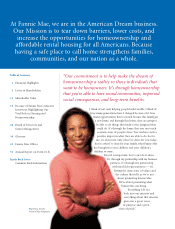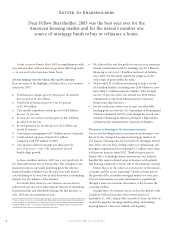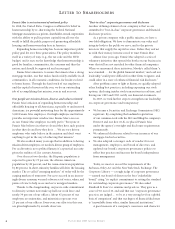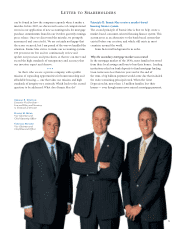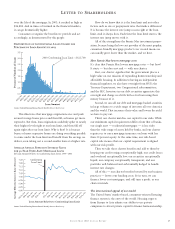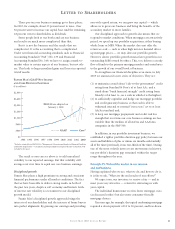Fannie Mae 2003 Annual Report Download - page 9
Download and view the complete annual report
Please find page 9 of the 2003 Fannie Mae annual report below. You can navigate through the pages in the report by either clicking on the pages listed below, or by using the keyword search tool below to find specific information within the annual report.
7
FANNIE MAE 2003 ANNUAL REPORT
over the life of the mortgage. In 2003, it reached as high as
$26,800. And in times of turmoil in the financial markets,
it can go dramatically higher.
Consumers recognize the benefits we provide and act
accordingly, as demonstrated by this graph:
This illustrates that mortgage originations rise and peak
around average home prices and then fall, as homes get more
expensive. But then, loan originations suddenly spike to nearly
their highest levels right at our loan limit, and then fall off
again right after our loan limit. Why is that? It is because
buyers of more expensive homes are doing everything possible
to come under the loan limit and benefit from the savings we
deliver, even taking out a second smaller loan at a higher rate.
How do we know that it is the loan limit and not other
factors such as size or prepayment rates that make a difference?
It is because the interest rate jump occurs right at the loan
limit. And it always does. Each time the loan limit moves, the
interest rate jump moves with it.
All of this strengthens the Fannie Mae investment propo-
sition, because being the low-cost provider of the most popular,
consumer-friendly mortgage product ever created means we
can usually grow faster than the market, and we have.
How Fannie Mae lowers mortgage costs
It’s clear that Fannie Mae lowers mortgage rates — but how?
It starts — but does not end — with our charter.
First, our charter signifies that the government places a
high value on our mission of expanding homeownership and
affordable housing. In addition to having an independent
financial regulator, we also have oversight from HUD, the
Treasury Department, two Congressional subcommittees,
and the SEC. Investors in our debt securities appreciate this
oversight and charge us a little bit less for borrowing their
money because of it.
Second, we can sell our debt and mortgage-backed securities
in large volumes to a wide range of investors all over America
and the world. That increases their value and lowers the yield
we have to pay out.
Third, our charter matches our capital to our risks. While
our minimum capital requirement differs from that of banks,
our single asset — residential mortgages — is less risky
than the wide range of assets held by banks, and our charter
requires us to carry mortgage insurance on loans with less
than 20 percent equity. At the same time, our risk-based
capital rule insures that our capital requirement is aligned
with our risk profile.
Then we take these charter benefits and add to them by
keeping our credit ratings exceptionally high; our credit losses
and overhead exceptionally low; our securities exceptionally
liquid; our company exceptionally transparent; and our
portfolio well-balanced and substantially hedged to handle
interest rate changes.
All of this — our charter benefits boosted by our business
practices — lowers our funding costs. So in turn, we can
finance lower-cost mortgages, and still turn a profit, as our
charter intends.
The international appeal of our model
The United States’ market-based, consumer-oriented housing
finance system is the envy of the world. Housing experts
from Europe to Asia admire our ability to use private
companies to attract private capital to finance homeownership.
LETTER TO SHAREHOLDERS
2003 Conforming Loan Limit - $322,700
Source: Federal Housing Finance Board, Monthly Interest Rate Survey
Source: Federal Housing Finance Board, Monthly Interest Rate Survey


